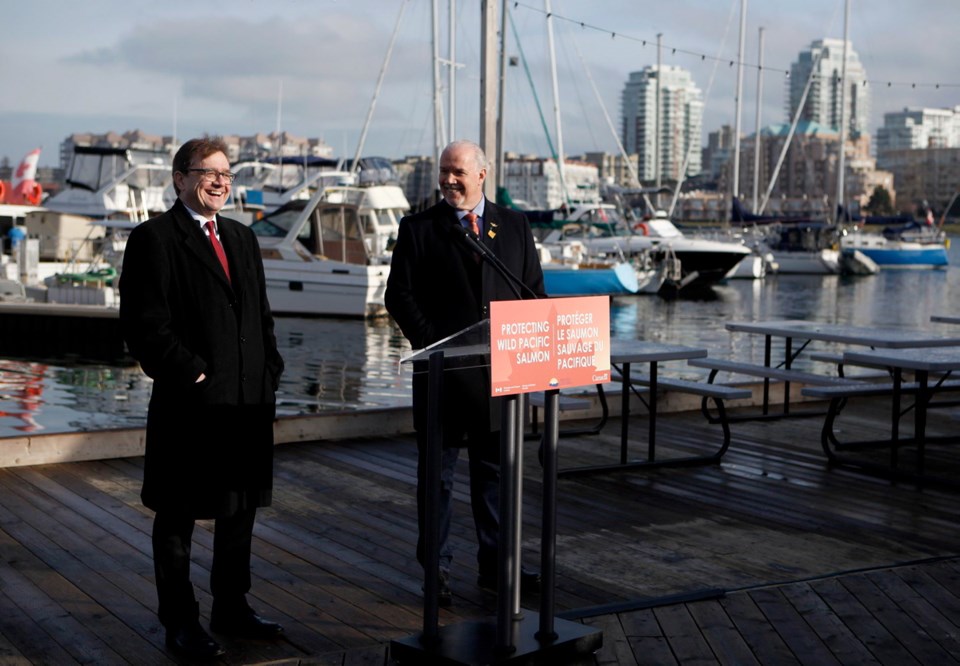The federal and provincial government have teamed up to commit $143 million over the next five years to protect and restore wild salmon stocks — some of which are in danger of collapse.
Proposals are being accepted to pay for salmon-related projects related to innovation, infrastructure and science, federal Fisheries Minister Jonathan Wilkinson and Premier John Horgan announced Friday.
“British Columbians are rightly concerned about the state of several wild salmon stocks,” Wilkinson said at Fisherman’s Wharf on Friday.
“Since the 1980s, wild Pacific salmon have faced challenges due to a multitude of stressors, including climate change.”
Horgan pointed to the youth who rallied Friday in front of the nearby legislature to call for action on climate change.
“When it comes to wild salmon stocks, there is no better indicator of the challenges we face than rising water temperatures, low snowpack, rivers that aren’t full with enough water to sustain our salmon, and that’s where we need to intervene,” Horgan said.
The federal government is putting in $100 million and the province is contributing $42.85 million to the B.C. Salmon Restoration and Innovation Fund, first announced late last year.
“The fund is now open for business,” Wilkinson said.
Another $5 million of federal money is going to the Pacific Salmon Endowment Fund to support the Vancouver-based Pacific Salmon Foundation.
Indigenous groups, conservationists, commercial and recreational fishermen and their organizations, academia and universities and research agencies can all apply to the new fund.
Money will go to activities such as protecting healthy and diverse salmon stocks for the long term, rebuilding salmon populations, restoring habitat and attaining sustainable-fishing sectors.
Horgan recalled seeing a hatchery in Sooke as a child and meeting volunteers who had been donating time for decades.
“If we are going to truly make a difference when it comes to salmon, we all have to work together.”
This means working with the state of Washington as well to protect salmon and orcas, he said, pointing to plans for co-operation and consensus in decision-making.
Wilkinson said he is in the midst of making a determination on chinook salmon.
Normally, recreational and commercial chinook salmon fishermen know by now what they can catch. But many chinook stocks are at dangerously low levels. Chinook are preferred food for endangered southern resident killer whales.
The recreational fishing sector around Vancouver Island which relies on chinook to attract customers for what is an economic foundation for coastal communities, is worried that catches could be drastically curtailed.
Wilkinson said: “Last year, we reduced the chinook salmon catch by one-third to reduce pressure on these stocks.”
Potential measures for this season are still being reviewed, but a determination needs to be made soon, he said. One factor will be the impact of last year’s catch reduction. Early Fraser River chinook will be returning from the ocean soon to spawn.
Ultimately, Wilkinson said, his job is to make the decision based on science. “The fundamental bottom line that underpins that decision will be the recovery of chinook salmon and what is required to ensure that we see the trends turn around over the coming years.”
Brian Riddell, chief executive and president of the Salmon Foundation, said the fund is “very unusual” because of the magnitude of the money, the scope of its goals, and the willingness of the senior governments to work so closely together.
“This gives a burden of responsibility and opportunity and a challenge for the people that will access this money to use it well.”
When it comes to possibilities for innovation, he pointed to Pacific salmon software developed jointly by the foundation, the Fisheries Department, the province and industry groups.
Anyone in B.C. will be able to access all important data related to wild salmon, such as returns, catches, and habitat information.



